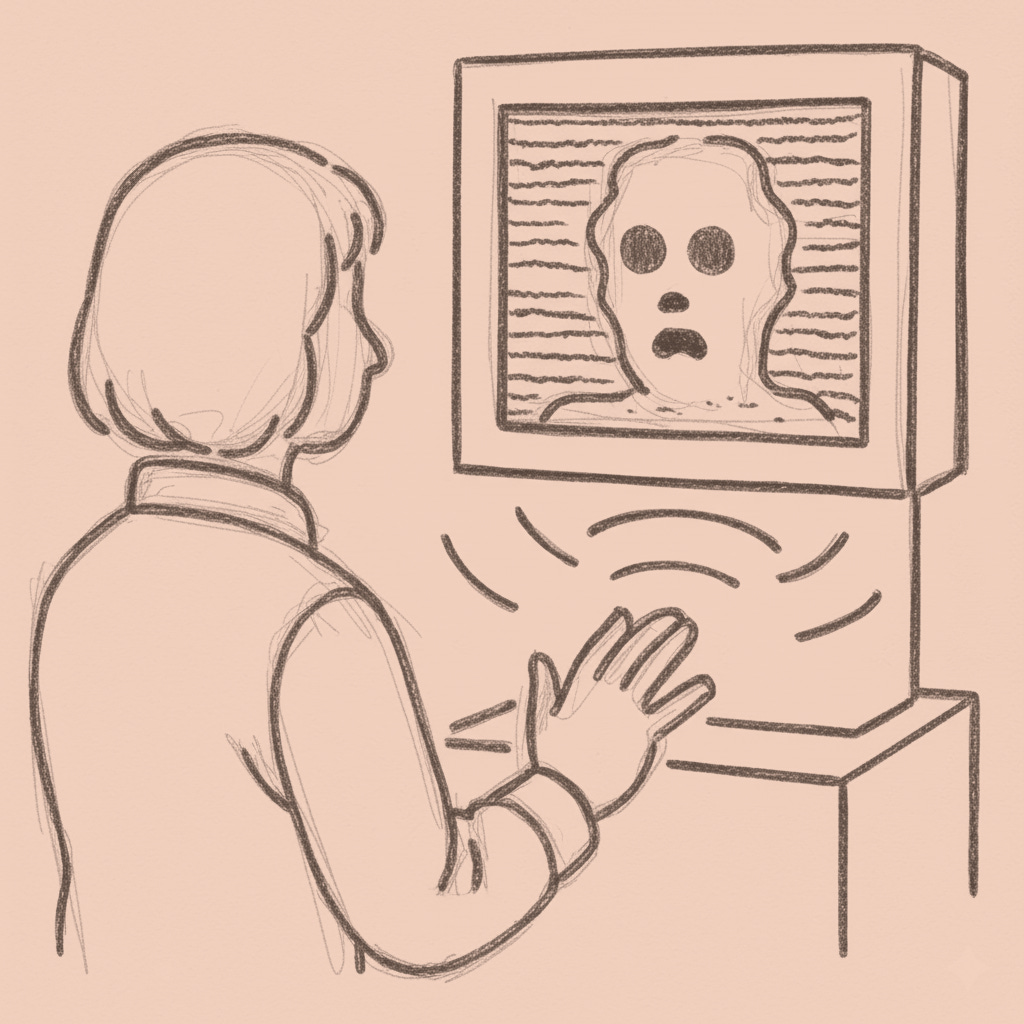The Museum Séance
When Archive Becomes Afterlife
The console asks which corpse you’d like to interrogate today. The screen resurrects someone dead before your birth, their face frozen in digital purgatory. Your question hangs for twenty seconds while the algorithm rummages through a thousand ghost recordings. Then the dead person’s lips move, and you pretend this isn’t necromancy with better UX.
The museum calls this “Voices from the Front.” The technology company that built it calls their platform “conversational AI.” The museum director calls it preservation. What nobody’s calling it, at least not yet, is what it actually is: the beta test for an industry that will convince you the dead are still available for consultation, provided you can pay the subscription fee.
Two institutions are teaching millions of visitors that talking to sophisticated retrieval systems feels like talking to people. That this is normal, educational, and emotionally appropriate.
The Imperial War Museum in London transcribed and indexed 20,000 hours of oral history testimony using AI. Veterans of both world wars. Holocaust survivors. Witnesses to every major conflict of the twentieth century.
The National WWII Museum deployed StoryFile’s technology to interview eighteen individuals. Up to a thousand questions per subject. Thirteen cameras capturing every angle.
Both projects frame themselves as preservation. Both are building something else entirely.
The Mechanism
The technology doesn’t generate responses. That’s their first reassurance, the distinction that makes this feel different from ChatGPT hallucinating your grandmother’s wisdom. It’s just search, they insist. Sophisticated search wearing conversation’s skin, the digital equivalent of summoning the dead with better lighting.
Everything you hear came from actual interviews. The AI retrieves and matches pre-recorded audio and video to your spoken questions. Search technology, fundamentally.
StoryFile used thirteen cameras to film subjects from every angle, creating volumetric video designed for eventual holographic display. The subjects answered hundreds or thousands of questions about their wartime experiences, their lives, their reflections. The AI indexes these responses and attempts to match visitor questions to appropriate clips. Initially the system takes up to twenty seconds to find answers, but improves with use.
The Imperial War Museum’s implementation focuses on searchability. Their platform lets users ask questions in natural language and surface relevant clips complete with citations. One example: a veteran’s admission of fear during flying training in World War I. Something that might take researchers years to find through conventional archive methods, now surfaced instantly.
These are genuinely useful tools. The technology does what it claims. Twenty thousand hours of testimony becomes searchable, discoverable, preserved. Veterans who spent their final years worrying their stories would die with them can rest easier.
It’s just not the whole story. The institutions deploying these tools are using very different language to describe what they’ve built.
The Resurrection Business
The Imperial War Museum’s director called this “resurrection, not replacement.” Let that language curdle in your mouth. Resurrection. The museum entered the afterlife business on £5 million of public money. Some grants officer approved funding for “AI-enabled archive search” while the director, on record, deployed theological language like it was just another marketing term. This is how category shifts happen. Not through philosophical debate but through grant applications and euphemistic language.
Through museum directors testing language at conferences and finding nobody pushes back. Through institutional validation that converts “is this okay?” into “of course this is educational.”
One of the National WWII Museum’s participants, Medal of Honor recipient Hershel “Woody” Williams, died in 2022. Visitors can still “talk” to him. Holocaust survivor Aaron Elster died in 2018, shortly after his interview. The StoryFile CEO later realized Elster had participated specifically because he wanted to continue answering questions after his death.
“That was his intent in being involved in the programme,” the CEO explained. As if this were obvious and natural rather than the sentence where we slipped from archive into afterlife without anyone marking the transition.
The National WWII Museum positions the technology as maintaining the connection they used to provide through volunteer veterans greeting visitors and sharing stories. As that generation aged and those living connections became absent, the museum turned to AI to keep the conversations going.
This framing is sympathetic. It’s also revealing. The museum had a visitor experience problem: the people who made their exhibits compelling by being alive and present were dying. They solved it with technology that simulates presence without requiring anyone to actually be present.
The museum had a “living person shortage” problem and solved it with AI.
The Docent Script
Watch the linguistic contortions that transform macabre into educational. Museum docents deploy present tense like anesthesia: “This is Corporal Martinez. He served in the Pacific Theater. You can ask him about his experiences.” Never “here’s a recording of” or “here’s archived testimony from.” Present tense. Active voice. As if Corporal Martinez waits in the next room rather than having been dead for six years.
The interface design does heavy lifting here. Life-sized video at eye level. The veteran’s image appearing when visitors select them, as if they just arrived for the conversation. Visitors speak their questions aloud rather than typing them. The response comes as video with synchronized audio. Every design choice pushes the brain toward the pattern it knows: this is conversation with a person, not a query to a database.
Younger visitors who grew up with Siri and Alexa already find talking to systems normal. The uncanny valley here isn’t voice interaction with technology. It’s that the technology is wearing a dead person’s face and the museum is calling this education rather than necromancy with better UX.
But even that discomfort is fading. A decade ago, the idea of recording your parents answering thousands of questions so you could keep “talking” to them after death would have registered as Black Mirror horror. Now it’s museum education. The category shift happened through accumulation of normalized interactions, each one slightly less strange than the last.
The Pitch Meeting
This validated behavior is already a pitch deck, presented right now to VCs nodding because they recognize the pattern: normalize through institutions, monetize through grief. A CEO explains how museums provided proof-of-concept for “Afterlife-as-a-Service,” slide deck opening with “Grief: An Undermonetized Vertical” like it’s just another market opportunity rather than the final commodification of human connection.
TAM calculations show billions. Customer acquisition through terminal illness diagnosis partnerships with healthcare providers. The business model is subscription, naturally. Monthly fees for continued access to your loved ones, tiered pricing based on recording quality and response depth.
Premium features include interpolated responses. “Your mother, but with AI-generated answers to questions she never actually answered, trained on her documented responses and speaking patterns.” The retention metrics are remarkable. Grief doesn’t exhaust itself, making churn analysis philosophically complicated. One slide handles the obvious question: “Lifetime Value Finally Means Something.”
He’s careful with the language. Never “talking to dead people.” Always “conversational access to preserved testimony.” Not “simulation of deceased relatives.” “Interactive memorial experience.”
The VCs nod. Museums already validated the use case. The technology works. The market is massive. The only question is go-to-market strategy.
This isn’t satire. This is what the pitch meetings already sound like. Visitors are just seeing what the euphemistic language actually means.
The Product Roadmap (Three Years Out)
The enterprise division offers tiered packages that read like a menu for digital afterlife stratification. Basic: smartphone video, 100 questions, standard voice matching. Premium: multi-angle capture, 1,000 custom questions, professional interviewer who extracts stories that will sound authentic when algorithms replay them. Enterprise: volumetric capture, unlimited questions, emotional tone preservation, holographic licensing for those who want their dead to haunt their living rooms like expensive ghosts.
The onboarding flow handles the uncomfortable parts through design. Customers don’t “record their dying parent.” They “preserve family history.” They’re not “building a chatbot of their deceased mother.” They’re “ensuring her stories and wisdom remain accessible to future generations.” The language does the work of making this feel like scrapbooking rather than whatever it actually is.
Integration partnerships emerge quickly. Funeral homes offer recording services as part of memorial packages. Estate planning attorneys recommend documentation sessions. Healthcare systems partner for “legacy preservation” programs targeting terminal diagnosis patients. Each partnership comes with its own euphemistic framing, its own way of making the category shift feel natural.
The business model reveals the incentive structure. Free tier with limited responses, just enough to get family members hooked. Then the upsell: “Your father has 237 stories we haven’t made available yet. Upgrade to Premium for unlimited access.” Subscription pricing means continuous revenue from grief that doesn’t resolve.
Support tickets reveal the psychological dynamics. “My mother’s responses don’t sound like her anymore after the update.” “Can I get the old version back?” The company learns that people want consistency more than improvement. They start offering “personality lock” as premium feature.
This is already being built. The infrastructure is live. The pricing tiers exist. The only question is how quickly museum validation converts into consumer adoption.
The Stratification Layer
The wealthy already record extensive interviews (thousands of questions, multiple camera angles, professional interviewers who extract the very essence of a person). Everything required for convincing simulation. Their digital versions persist as long as someone pays hosting fees, creating digital aristocracy where the dead remain accessible to those who can afford immortality by subscription.
The rest of us will get whatever we can afford. Basic packages. Limited responses. Generic questions only. Smartphone video quality. Twenty-minute recording sessions instead of twenty hours. The free tier that offers just enough to demonstrate what you’re missing.
Death remains universal but digital persistence becomes stratified by class. Just like healthcare. Just like education. Just like longevity itself. The wealthy get extensive digital afterlives. The middle class gets basic packages. The poor get whatever free tier provides minimal interaction before the upgrade prompts appear.
Someone is choosing this trajectory. Product team’s are designing these tiers right now. Museum boards are approving expanded partnerships. Investors are calculating returns based on how long families will pay to keep accessing their dead relatives. These are choices being made in specific conference rooms by specific people with specific incentives.
What This Actually Is
Not resurrection. Not preservation. Not education.
What museums build is infrastructure for managed grief. For relationships mediated by technology. For the idea that death’s appropriate response is better search algorithms rather than acceptance that the dead are actually gone, and that this acceptance might be the last human experience we haven’t outsourced to algorithms yet.
The technology works. The intentions are good. The historical preservation is real. And institutions are teaching millions of people that talking to retrieval systems wearing the faces of the dead is normal, appropriate, even virtuous.
The consumer applications are already being built. The pitch meetings are already happening. StoryFile already monetizes this. The question isn’t whether someone will scale it. The question is what it reveals about cultural assumptions that have quietly shifted enough to make this feel like natural progression rather than category error.
Stand in front of that console. Pick your veteran. Ask your question. Wait for the algorithm to retrieve the appropriate response. Watch the dead person’s lips move. “This is strange and uncomfortable” became “this is just how museums work now” in less than five years, the transition so gradual we barely noticed ourselves accepting what would have been Black Mirror horror a decade ago. The museum calls it resurrection. The company calls it conversational AI. The visitors call it educational. The grant applications call it preservation. The product roadmap calls it Afterlife-as-a-Service.
Soon we’ll call it normal.
That’s the pattern being validated in museum galleries now. Not through debate about whether we want this future, but through accumulated interactions that make each step feel inevitable. Through institutional validation that converts category confusion into educational opportunity. Through infrastructure built by people who understand exactly what they’re enabling and choose to enable it anyway, because economic incentives point toward growth and grief, unlike attention spans, doesn’t exhaust itself.
Watch how the language keeps shifting to make room for what comes next.
Research Notes: The Museum Séance
The hardest part of researching this piece was realizing the technology isn’t coming. It’s already here. Found it at a 2022 funeral where mourners could ask the deceased questions and get answers. Not a concept. Not a prototype. An actual commercial service, marketed and operational.









